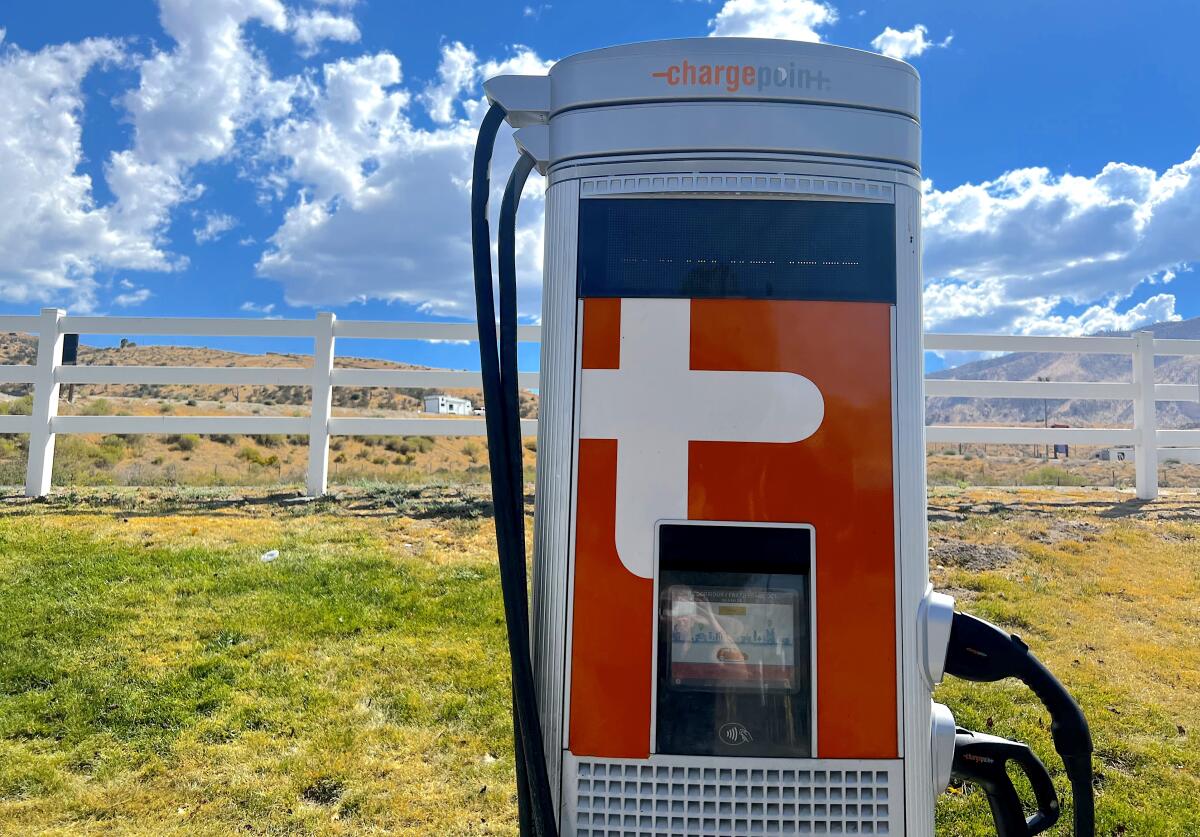Opinion: Yes, EV road tripping can be done. But charging needs to be better

The first time I drove off a dealer lot in an electric vehicle, it was in a bare-bones Nissan Leaf with 150 miles of range. Having been warned about so-called range anxiety, I quickly learned that 150 miles was more than enough for driving around Los Angeles. That was almost five years ago.
Now, I have a 250-mile-range Chevrolet Bolt, and although road trips still require planning, fast-charging EV stations have proliferated enough to make longer drives a little more relaxing. Just last month, for example, I drove my children to a desert tortoise preserve near California City and was able to make an easy 45-minute charging stop in the town of Mojave, which up until recently had reliable EV service only for Tesla drivers. Things are getting better.
But they’re still not good enough for mass EV adoption in California, a point made by deputy editorial page editor Mariel Garza in her recent piece saying she may trade in her fully electric Kia Niro for a gas-powered plug-in hybrid. Garza’s piece touched off a lively discussion among our letter writers, many of whom shared their experiences driving long distances in EVs and spotting weaknesses in the charging network.
————
To the editor: I agree with every complaint in Garza’s commentary on EVs, but I think she left out the most important problem.
Tesla and other EVs do not have interchangeable charging stations. Imagine being on a road trip and pulling into a town along the way in your Chevrolet and discovering that the town’s one gas station only sells fuel for Fords.
I really believe that the future of EVs would be much brighter if all car manufacturers agreed to a single standard for fast-charge stations. Having charging stations that could service all EVs would increase their patronage and would almost certainly make them a better investment for the entrepreneurs building them.
David Roberts, New Braunfels, Texas
..
To the editor: As the lead tester for the study performed by UC Berkeley and the nonprofit Cool the Earth on fast-charging reliability, I heartily agree with recent criticisms of the state of public charging.
Thankfully, 80% of charging is done at home, but what is at risk is equitable access to charging. Those who live in multi-family housing cannot install a home charger.
The federal government recently set a new requirement of 97% up-time for stations, but it lacks real “teeth.” It is now up to the California Energy Commission to set strong rules that hold the industry accountable.
Reliable chargers are essential for mass EV adoption, and Tesla has figured it out. If other charging companies want to keep their taxpayer subsidies, it’s past time for them to figure it out as well.
The climate clock is ticking, and the future of the electric revolution is at stake.
Susannah Saunders, San Anselmo, Calif.
..
To the editor: I built my first electric vehicle in my garage because it was the only way to drive electric. I have been driving them ever since.
You can drive all over California (and the U.S.) in an EV. I’ve made three round trips from San Francisco to Los Angeles in as many weeks. I’ve also driven my EV from the Bay Area to Montana and Utah.
Over the last decade I have been inconvenienced, yes, but never stranded. The EV infrastructure of 2023 is vastly superior to that of 2013, and it is getting better every month.
Garza mentions the need to get our act together with respect to policy, and she is 100% spot on. However, she focuses on policy for charging away from home. Here too she is accurate, but misses the larger picture. Where California policy is embarrassingly inadequate is for charging at home.
Charging at home is great if you own your own single-family home. If not, buying an EV is typically not a good idea. The topic of charging at home for people who live in multi-family housing is the story that needs to be told.
John Higham, Mountain View, Calif.
..
To the editor: It is striking that Garza focuses mostly on her own needs and much less on the needs of society now and in the future. That is how we got here, of course.
We cannot replicate the internal combustion engine car in the coming world of electrics. EVs are first and foremost for urban transport. To build all those cars for the occasional long-distance trip wouldn’t be sensible.
We need light cars with small batteries for economical commuting. These are not being built in the U.S. because the legacy automakers need to sell high-end vehicles to tide them over.
What we need is the modern “people’s car,” and that’s where the federal incentive program should have been focused.
The other urban imperative is to move toward reduction in reliance on personally owned automotive transport through the facilitation of alternatives. That will be resisted by those who are well served by the infrastructure that exists, but it needs to happen nonetheless.
Siegfried Othmer, Woodland Hills







